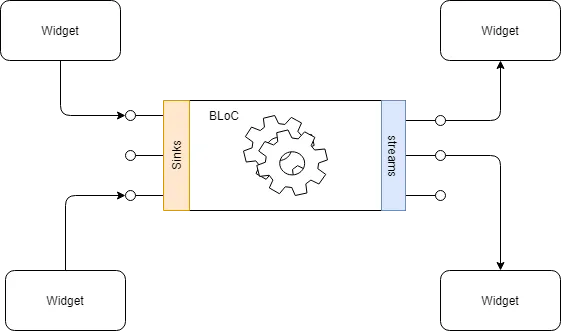这是项目地址,下面来阐述下产生背景和它的一些特点。
接触 Flutter 也有一段时间了,在如何管理状态和处理数据流这块,并没有一个可以直接拿来用的现成方案。好吧,其实有,一个是 flutter_redux,一个是 flutter_bloc。先来说说 flutter_redux,这个可以算是 redux 在 flutter 的官方实现了,主要由两部分组成: StoreProvider 和 StoreConnector,前者用来保存 store,后者用来响应新的 state,看一个代码片段:
// Every time the button is tapped, an action is dispatched and
// run through the reducer. After the reducer updates the state,
// the Widget will be automatically rebuilt with the latest
// count. No need to manually manage subscriptions or Streams!
new StoreConnector<int, String>(
converter: (store) => store.state.toString(),
builder: (context, count) {
return new Text(
count,
style: Theme.of(context).textTheme.display1,
);
},
)这段代码的问题在于只要 reducer 有更新 state,那么所有消费该 Store 的 Connector 就会被 rebuild,哪怕这个 state 有 10 个属性,而 reducer 只是改了其中的一个 bool 值。
// Creates the base [NextDispatcher].
//
// The base NextDispatcher will be called after all other middleware provided
// by the user have been run. Its job is simple: Run the current state through
// the reducer, save the result, and notify any subscribers.
NextDispatcher _createReduceAndNotify(bool distinct) {
return (dynamic action) {
final state = reducer(_state, action);
if (distinct && state == _state) return;
_state = state;
_changeController.add(state);
};
}这是 redux 这个 library 里的 Notify 机制,采用的是 == 判断,这就是问题。在 react-redux 中,这块是有优化的,通过 connect 的 mapStateToProps,可以让 Component 指定关心 State 的哪些属性,然后在 react-redux 内部会对 mapStateToProps 的返回值和上次保存的进行比较,如果不一样再 rebuild,这样的好处是只有当 Component 关心的哪些属性真的变化时才进行 render。而 flutter_redux 无法做到这点(可能跟 flutter 不让用反射有关),效率上就会打折扣。
再来看看 flutter_bloc,这也是关注度蛮高的一个项目,说这个之前先说说 bloc,这是 flutter 提的一个概念,运行机制大致如下:

它更像一个提案,缺少标准和实现。flutter_bloc 就是对这个提案的一个实现。这个实现本质上没觉得跟 flutter_redux 有太大的区别,而复杂度倒是增加了不少,还提出了一些新的概念(比如 BlocSupervisor, BlocDelegate, Transation),增加了理解上的困难。在处理核心的 state 问题上依旧跟 flutter_redux 一样,甚至都没有做 == check。
void _bindStateSubject() {
Event currentEvent;
(transform(_eventSubject) as Observable<Event>).concatMap((Event event) {
currentEvent = event;
return mapEventToState(_stateSubject.value, event);
}).forEach(
(State nextState) {
final transition = Transition(
currentState: _stateSubject.value,
event: currentEvent,
nextState: nextState,
);
BlocSupervisor().delegate?.onTransition(transition);
onTransition(transition);
_stateSubject.add(nextState);
},
);
}可以看到在往 _stateSubject 里塞 nextState 时甚至都没有跟之前的 state 进行判断。同时从作者的意图上是希望多个 bloc 一起使用的,这也会造成使用上的不便(比如我这个 Event 到底应该 dispatch 给哪个 bloc?)。
return BlocBuilder<LoginEvent, LoginState>(
bloc: widget.loginBloc,
builder: (
BuildContext context,
LoginState loginState,
) {
if (_loginSucceeded(loginState)) {
widget.authBloc.dispatch(Login(token: loginState.token));
widget.loginBloc.dispatch(LoggedIn());
}
}
);综上,这两格 Library 都无法满足我,只能再造一个轮子了。
Bloc_Redux
其实只要让 flutter_redux 能够更高效地把状态变化传递给 widgets,问题就解决了。那如何做呢?返回一个新的 state,也就是 reducer 之路,应该是行不通了,因为无法高效地找到变化过的属性,即使可以,还要维护一个属性跟 widgets 的 map,太复杂了。换一个想法,Flutter 不是提供了 StreamBuilder 么,那让 Widget 自己选择 listen 哪些 stream,然后当一个 action dispatch 过来后,这些 stream 获得相应的改变不就行了么?

其中处理 action 的 reducer 被替换成了 bloc,来看一下核心代码。
/// Action
///
/// every action should extends this class
abstract class BRAction<T> {
T payload;
}
/// State
///
/// Input are used to change state.
/// usually filled with StreamController / BehaviorSubject.
/// handled by blocs.
///
/// implements disposable because stream controllers needs to be disposed.
/// they will be called within store's dispose method.
abstract class BRStateInput implements Disposable {}
/// Output are streams.
/// followed by input. like someController.stream
/// UI will use it as data source.
abstract class BRStateOutput {}
/// State
///
/// Combine these two into one.
abstract class BRState<T extends BRStateInput, U extends BRStateOutput> {
T input;
U output;
}
/// Bloc
///
/// like reducers in redux, but don't return a new state.
/// when they found something needs to change, just update state's input
/// then state's output will change accordingly.
typedef Bloc<T extends BRStateInput> = void Function(BRAction action, T input);
/// Store
///
/// widget use `store.dispatch` to send action
/// store will iterate all blocs to handle this action
///
/// if this is an async action, blocs can dispatch another action
/// after data has received from remote.
abstract class BRStore<T extends BRStateInput, U extends BRState>
implements Disposable {
List<Bloc<T>> blocs;
U state;
void dispatch(BRAction action) {
blocs.forEach((f) => f(action, state.input));
}
dispose() {
state.input.dispose();
}
}其中 State 被分成了 StateInput 和 StateOutput,其中 Input 部分给 Bloc,方便更新 Stream;Output 部分给 Widgets,方便接收最新数据。同时 Store 也有一个 dispose 方法,因为到时 store 会被放到 StoreProvider 里,当它被 dispose 时,可以让 store 也 dispose,让那些 stream 可以被 close。
就这么简单,我们来看一个 demo:
/// Actions
class ColorActionSelect extends BRAction<Color> {}
/// State
class ColorStateInput extends BRStateInput {
final BehaviorSubject<Color> selectedColor = BehaviorSubject();
final BehaviorSubject<List<ColorModel>> colors = BehaviorSubject();
dispose() {
selectedColor.close();
colors.close();
}
}
class ColorStateOutput extends BRStateOutput {
StreamWithInitialData<Color> selectedColor;
StreamWithInitialData<List<ColorModel>> colors;
ColorStateOutput(ColorStateInput input) {
selectedColor = StreamWithInitialData(
input.selectedColor.stream, input.selectedColor.value);
colors = StreamWithInitialData(input.colors.stream, input.colors.value);
}
}
class ColorState extends BRState<ColorStateInput, ColorStateOutput> {
ColorState() {
input = ColorStateInput();
output = ColorStateOutput(input);
}
}
/// Blocs
Bloc<ColorStateInput> colorSelectHandler = (action, input) {
if (action is ColorActionSelect) {
input.selectedColor.add(action.payload);
var colors = input.colors.value
.map((colorModel) => colorModel
..isSelected = colorModel.color.value == action.payload.value)
.toList();
input.colors.add(colors);
}
};
/// Store
class ColorStore extends BRStore<ColorStateInput, ColorState> {
ColorStore() {
state = ColorState();
blocs = [colorSelectHandler];
// init
var _colors = List<ColorModel>.generate(
30, (int index) => ColorModel(RandomColor(index).randomColor()));
_colors[0].isSelected = true;
state.input.colors.add(_colors);
state.input.selectedColor.add(_colors[0].color);
}
}Store 就像人的大脑,负责接收信息做出决策,而信息的处理者就是一个个的 Bloc。再来看看 Widget 是如何接收数据,发送 action 的。
class ColorsWidget extends StatelessWidget {
@override
Widget build(BuildContext context) {
final store = StoreProvider.of<ColorStore>(context);
final colors = store.state.output.colors;
return StreamBuilder<List<ColorModel>>(
stream: colors.stream,
initialData: colors.initialData,
builder: (context, snapshot) {
final colors = snapshot.data;
return SliverGrid.count(
crossAxisCount: 6,
children: colors.map((colorModel) {
return GestureDetector(
onTap: () {
store.dispatch(
ColorActionSelect()..payload = colorModel.color);
},
child: Container(
decoration: BoxDecoration(
color: colorModel.color,
border: Border.all(width: colorModel.isSelected ? 4 : 0)),
),
);
}).toList());
},
);
}
}通过 StreamBuilder 来消费 state output,通过 store.dispatch 来发送 action,It’s that simple.
最后,附上项目地址:https://github.com/limboy/bloc_redux
